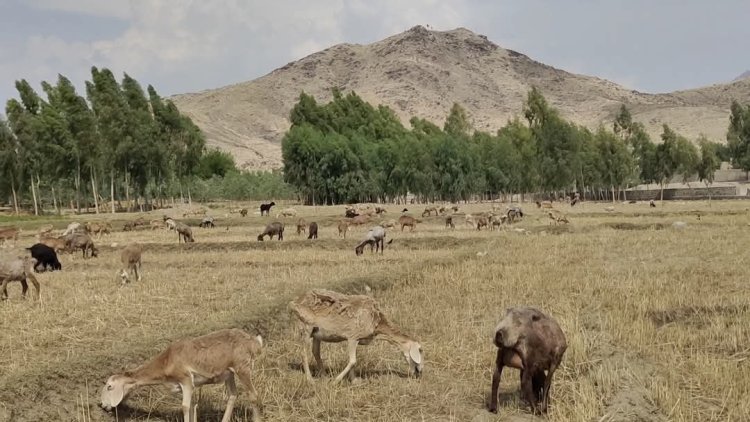Drought Ravages Grazing Lands Across Afghanistan

Several provinces in Afghanistan have been hit hard by persistent droughts, leading to water shortages that have recently posed serious challenges for livestock owners. As a result, many herders have been forced to sell their animals.
Gulabuddin, a shepherd from the mountainous Badpakh district of Laghman province, has been herding for the past 20 years. He says the silence of early mornings is broken only by the sound of bells on his herd. Every day, he takes his 60 goats and sheep to different areas and pastures in search of grass.
He explains that herding has been passed down to him from his ancestors, and he spends his days and nights among the animals, often in poverty. According to him, in recent years, the mountains and fields have become barren due to lack of rain and prolonged drought, making it difficult for the animals to graze properly.
He says, “There used to be rainfall, and the mountains and fields would turn green. We would graze our livestock there. But in the past few years, drought has increased, and the mountains no longer turn green—there is no grass. I’ve now decided to sell my livestock and start another business because there are no grazing lands, and many of my animals have died of hunger. I have no choice but to change my livelihood.”
Zainullah, another shepherd from the Muqur district of Ghazni province, says that he used to take his herds for grazing not only within Ghazni but across various provinces of Afghanistan. However, in recent years, those pastures have vanished and turned into barren lands.
According to him, the drought, water scarcity, and loss of grazing lands have made herding increasingly difficult. Shepherds can no longer easily find grass to feed their animals or take proper care of them.
He explains, “In the past, during spring, we used to take our herds to provinces like Nangarhar, Laghman, and Kunar. As the weather warmed, nomads from those areas would come to Kabul, Ghazni, and other provinces. But for several years now, grazing lands have disappeared in all provinces. This has deeply worried livestock owners. If grazing lands are not protected or the drought continues, people will abandon livestock farming altogether.”
He adds that many livestock owners are being forced to give up herding due to the high cost of feed and the lack of grazing lands.
Meanwhile, experts in agriculture and livestock say that herders have recently faced serious challenges due to drought, which has put this traditional livelihood at risk of decline.
Seyed Omran Ashna, an agricultural and livestock specialist, says that in recent years, grazing lands have been either converted into farmland or illegally seized. In the remaining lands, due to climate change, there is no sufficient grass for grazing.
He explains that in past years, there were still some pastures available that could partially meet the needs of livestock owners. However, in recent years, many of these areas have been seized or destroyed by floods, worsening the problems for herders.
He adds, “Agriculture and livestock are considered vital for a country’s economic development. Unfortunately, in Afghanistan, this sector has not received proper attention. In many areas, grazing lands have been seized or turned into residential settlements. The few remaining areas are also disappearing day by day due to neglect and drought. This will have devastating consequences for livestock farming.”
The UN Food and Agriculture Organization (FAO) has also expressed concern about the growing challenges in Afghanistan’s livestock sector and emphasized that supporting Afghan farmers and herders must be a priority.
Afghanistan is a mountainous country known both regionally and globally as an agricultural nation. Its green pastures once made it an ideal place for raising livestock. However, these grazing lands are now drying up and face the risk of vanishing altogether.
It is worth noting that in recent years, drought has not only negatively impacted agriculture and livestock, but also affected people’s everyday lives in many other ways.
